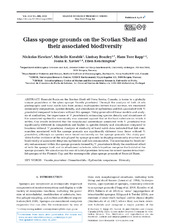| dc.contributor.author | Hawkes, Nickolas James | |
| dc.contributor.author | Korabik, Michelle | |
| dc.contributor.author | Beazley, Lindsay | |
| dc.contributor.author | Rapp, Hans Tore | |
| dc.contributor.author | Xavier, Joana R. | |
| dc.contributor.author | Kenchington, Ellen | |
| dc.date.accessioned | 2020-07-02T08:55:10Z | |
| dc.date.available | 2020-07-02T08:55:10Z | |
| dc.date.issued | 2019 | |
| dc.Published | Hawkes NJ, Korabik, Beazley L, Rapp HT, Xavier JR, Kenchington E. Glass sponge grounds on the Scotian Shelf and their associated biodiversity. Marine Ecology Progress Series. 2019;614:91-109 | eng |
| dc.identifier.issn | 0171-8630 | en_US |
| dc.identifier.issn | 1616-1599 | en_US |
| dc.identifier.uri | https://hdl.handle.net/1956/23232 | |
| dc.description.abstract | Emerald Basin on the Scotian Shelf off Nova Scotia, Canada, is home to a globally unique population of the glass sponge Vazella pourtalesi. Through the analysis of both in situ photographs and trawl catch data from annual multispecies bottom-trawl surveys, we examined community composition, species density, and abundance of epibenthos and fish associated with V. pourtalesi compared to locations without this sponge. Using generalized linear models and analysis of similarities, the importance of V. pourtalesi in enhancing species density and abundance of the associated epibenthic community was assessed against that of the hard substrate on which it settles. Our results indicated that the megafaunal assemblage associated with V. pourtalesi was significantly different in composition and higher in species density and abundance compared to locations without V. pourtalesi. Analysis of similarity of trawl catch data indicated that fish communities associated with the sponge grounds are significantly different from those without V. pourtalesi, although no species were found exclusively on the sponge grounds. Our study provides further evidence of the role played by sponge grounds in shaping community structure and biodiversity of associated deep-sea epibenthic and fish communities. The mechanism for biodiversity enhancement within the sponge grounds formed by V. pourtalesi is likely the combined effect of both the sponge itself and its attachment substrate, which together comprise the habitat of the sponge grounds. We also discuss the role of habitat provision between the mixed-species tetractinellid sponges of the Flemish Cap and the monospecific glass sponge grounds of Emerald Basin. | en_US |
| dc.language.iso | eng | eng |
| dc.publisher | Inter-Research | en_US |
| dc.rights | Attribution CC BY | eng |
| dc.rights.uri | http://creativecommons.org/licenses/by/4.0 | eng |
| dc.title | Glass sponge grounds on the Scotian Shelf and their associated biodiversity | en_US |
| dc.type | Peer reviewed | |
| dc.type | Journal article | |
| dc.date.updated | 2020-01-06T08:15:24Z | |
| dc.description.version | publishedVersion | en_US |
| dc.rights.holder | Copyright 2019 The Author(s) | en_US |
| dc.identifier.doi | https://doi.org/10.3354/meps12903 | |
| dc.identifier.cristin | 1711178 | |
| dc.source.journal | Marine Ecology Progress Series | |

